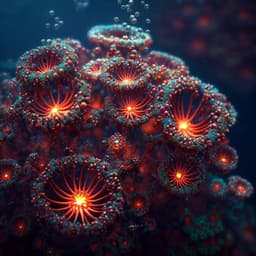
Engineering and Technology
Oxynitrides enabled photoelectrochemical water splitting with over 3,000 hrs stable operation in practical two-electrode configuration
Y. Xiao, X. Kong, et al.
This groundbreaking research showcases the stable operation of a Si and GaN photocathode for 3,000 hours without performance loss, with an innovative surface transformation enhancing hydrogen production. Conducted by Yixin Xiao, Xianghua Kong, and their esteemed colleagues, this study paves the way for efficient photoelectrochemical devices.
~3 min • Beginner • English
Introduction
The study addresses a central challenge in photoelectrochemical (PEC) water splitting: achieving long-term stability and efficiency in a practical two-electrode configuration. Prior progress has largely been evaluated in three-electrode setups, which do not capture full-cell behavior or counter-electrode effects and thus are insufficient indicators for commercial viability. Protection layers can enhance stability but typically require extrinsic catalysts and may compromise catalytic activity and charge transfer. Metal-nitrides, particularly GaN integrated with Si, offer tunable bandgaps, manufacturability, and potential stability. Earlier work reported self-improving behavior of GaN films in three-electrode tests, attributed to surface oxynitride formation, but it remained unknown whether such behavior could be sustained or enhanced with GaN nanowire (NW) morphologies dominated by nonpolar surfaces under practical two-electrode conditions, and what the atomic mechanism and catalytic properties of the oxynitride species are. This work investigates GaN NW/Si photocathodes to determine whether in-situ surface transformation to GaON can deliver high efficiency and ultra-long stability in two-electrode operation and elucidates the underlying mechanisms.
Literature Review
The paper reviews limitations of three-electrode PEC testing for assessing device stability and performance, noting that it excludes counter-electrode behavior and overall cell durability. While protection schemes (e.g., ALD TiO2, Al2O3) have improved stability for various semiconductors, they often require extrinsic HER catalysts and may reduce catalytic activity and conductivity, leading to tradeoffs between efficiency and stability. Prior high-efficiency photoelectrodes showing stability in three-electrode tests have often performed poorly in two-electrode configurations due to charge buildup, solution resistance, and intrinsic instability. III-nitrides (e.g., InGaN, GaN) integrated with Si offer bandgap tunability and scalability. Previous work indicated GaN surfaces could self-improve via oxynitride formation during PEC, but studies were limited to quasi-film morphologies and three-electrode configurations. Attempts to stabilize III–V photoelectrodes via nitridation (e.g., GaPN) improved stability at low N content but introduced defects at higher incorporation. GaON has typically been fabricated by nitridation of Ga2O3 at high temperatures, which is energy-intensive and yields inferior photocatalysts with lower stability. A need remained for intrinsic, catalytically active, stable surface states formed under operating conditions and validated in two-electrode tests.
Methodology
Device fabrication and growth: p-type Si(100) wafers (254–304 μm, 1–10 Ω·cm) were RCA cleaned and thermally oxidized (SiO2 250–300 nm at 1100 °C). Patterning left SiO2 on one side only; the other side remained exposed p-Si. Phosphorus diffusion (950 °C, 20 min) formed n+-Si (sheet resistance 8–11 Ω/sq, ~0.6 μm, donor ~1×10^20 cm^-3). Wafers were cleaned (buffered HF) and diced. In PAMBE, an N-terminated thin GaN quasi-film was first grown (~15 min, ~735 °C, Ga BEP ~2.2×10^-7 Torr, Si dopant cell 1250 °C, N2 0.45 sccm) to protect Si, followed by growth of n+-GaN nanowires under N-rich conditions (~735 °C, Ga BEP 6×10^-8 Torr, Si cell 1250 °C, N2 1 sccm, 350 W plasma, 4–5 h). NWs were ~600 nm long, ~100 nm diameter, with dominant nonpolar m-plane sidewalls.
Three-electrode PEC tests: Working electrode: GaN NW/Si; counter: IrOx; reference: Ag/AgCl; electrolyte: 0.5 M H2SO4; illumination: AM 1.5G one sun (and up to 9 suns in a flow cell to enhance mass transport). Measurements included chronoamperometry (CA), linear sweep voltammetry (LSV), electrochemical impedance spectroscopy (Nyquist), and Faradaic efficiency via gas chromatography. Al2O3 passivation (2 nm by ALD at 200 °C) and Pt photodeposition were used in control experiments to probe surface modification versus extrinsic catalysis. STEM-EDS/XPS checked counter-electrode contamination.
Two-electrode PEC tests: Practical cell configuration under AM 1.5G one sun in 0.5 M H2SO4 with 0.2 mM Triton X-100. Long-term CA at constant applied potential of -2.3 V vs IrOx; electrolyte replaced every 20–24 h. LSVs and EIS acquired at selected times. Faradaic efficiency measured initially (0–10 h) and during the last 10 h near 3000 h.
Characterization: XPS (O 1s and Ga 3d) at incident angle θ=60° to emphasize m-plane surfaces; valence band maximum (E_FS − E_VS) determination. SEM/STEM pre- and post-stability to monitor morphology and dimensions; ICP-MS quantified dissolved Ga. Faradaic efficiency determined by comparing evolved H2 (GC) to charge passed.
Theory: DFT calculations evaluated formation energies of GaON configurations on N-rich GaN m-plane surfaces and electronic structure (DOS, orbital-projected DOS), identifying metallic surface states, band bending, and bandgap narrowing. Four GaON configurations were screened; formation energies and Fermi-level shifts were computed; real-space charge densities around E_F visualized.
Key Findings
- Demonstrated ultralong stable two-electrode operation: GaN nanowire/Si photocathode operated stably for 3000 h at -2.3 V vs IrOx under AM 1.5G one-sun in 0.5 M H2SO4 + 0.2 mM Triton X-100 with photocurrent density ~29–30 mA/cm² (±10% over time) and Faradaic efficiency ~100% during the last 10 h.
- Initial two-electrode behavior improved over first ~10–40 h due to in-situ surface transformation: onset potential shifted positively (≈0.5 V), fill factor and photocurrent increased; saturation photocurrent ≈ -30 mA/cm² reached after ~40 h.
- Three-electrode self-improvement: At -0.4 V_RHE, photocurrent increased from ~0.6 to ~-35 mA/cm² over 40–50 h. After 100 h, onset potential V_on ≈ 0.36 V_RHE and J ≈ -30 mA/cm² at 0 V_RHE without extrinsic catalysts (comparable to Pt-loaded Si). EIS showed decreasing charge-transfer resistance over time.
- Concentrated light accelerates self-improvement: Under 9-sun illumination in a flow cell, V_on > 0.3 V_RHE achieved within 15 min; modification speed was ~100× faster than at 1 sun. Photocurrent of ~-165 mA/cm² at -0.3 V_RHE and stable operation >500 h with >150 mA/cm² at -0.4 V_RHE.
- Faradaic efficiency evolution: Three-electrode FE(H2) increased from 52% to >95% within 1.5 h at -0.4 V_RHE; in two-electrode tests, FE was 89–100% during the first 10 h and reached 100% by 10 h and remained ~100% at the end.
- Surface chemistry evidence: XPS O 1s revealed emergence of O–Ga–N peak at ~531.6 eV after 10 h, indicating formation of GaON on m-plane surfaces; Ga 3d showed a Ga–N–O peak at ~20.8 eV. Relative Ga–O peak intensity decreased after testing (oxide dissolution/consumption). Valence spectra showed E_FS−E_VS increased by ~0.5 eV post-10 h, consistent with improved charge transfer.
- Kinetics: Two-electrode Nyquist plots showed a ~two-order-of-magnitude reduction in charge-transfer resistance after 10 h.
- Stability of morphology and composition: SEM/STEM showed unchanged NW dimensions (~600 nm length, ~100 nm diameter) and coverage after 3000 h; ICP-MS detected negligible dissolved Ga (10–13 nmol across runs).
- DFT insights: Four GaON configurations on N-rich m-plane have negative formation energies (−4.07, −4.29, −3.95, −2.66 eV), indicating thermodynamic favorability. Oxygen incorporation metallizes the surface (Fermi level shifts into the conduction band by up to ~1.39 eV), narrows the effective surface bandgap from ~3.19 eV to ~1.83 eV, induces downward band bending, and creates localized metallic GaON nanoclusters acting as intrinsic HER sites. Metallic states arise from O p-, N p-, and Ga s/p-orbitals at the surface.
Discussion
The results directly address the challenge of achieving durable, efficient PEC operation in practical two-electrode configurations. The in-situ formation of GaON nanoclusters on N-terminated GaN NW m-planes acts as a native, atomically thin cocatalyst that enhances HER kinetics and stabilizes performance without extrinsic metal catalysts or thick protection layers. The transformation is driven by photocurrent and requires electrolyte exposure; higher photocurrent (via concentrated light) accelerates formation. XPS and band-edge shifts indicate reduced surface band bending and improved charge transfer, while DFT shows that O incorporation is thermodynamically favorable and generates metallic surface states that serve as electron sinks and active HER sites. Compared to traditional oxide protection layers that can impede catalysis and conductivity, these native GaON species avoid the efficiency–stability tradeoff, leading to unprecedented two-electrode stability (3000 h) that surpasses prior best reports (~300 h). The integration of GaN with Si provides manufacturability and scalability. These findings suggest a viable route for practical PEC devices by leveraging intrinsic, self-formed catalytic surface phases.
Conclusion
This work demonstrates an n+-GaN nanowire/Si photocathode that self-improves via in-situ formation of GaON on nanowire m-plane sidewalls, enabling ultra-stable two-electrode PEC H2 production for 3000 h at practical conditions with ~30 mA/cm² photocurrent and ~100% Faradaic efficiency, all without extrinsic cocatalysts. The study identifies morphology (dominant nonpolar surfaces) and photocurrent (illumination intensity) as key levers governing transformation kinetics. Spectroscopic and electrochemical evidence, supported by DFT, reveals that GaON forms readily on N-rich m-planes, creates localized metallic surface states, reduces band bending, and enhances HER kinetics. These insights overcome the conventional efficiency–stability dilemma and chart a path toward practical, durable PEC systems based on GaN/Si. Future work should determine ultimate failure limits and durability under harsher conditions (e.g., elevated temperature, concentrated sunlight), and explore generalization of in-situ oxynitride catalysis to other materials and device architectures.
Limitations
- The ultimate failure time of the photocathode was not determined; stability beyond 3000 h remains to be quantified.
- Long-term stability was demonstrated at a fixed applied potential (−2.3 V vs IrOx) and specific electrolyte (0.5 M H2SO4 with 0.2 mM Triton X-100); broader operating windows (pH, electrolytes, biases) were not exhaustively explored.
- Initial Faradaic efficiency was below 100% during the surface transformation period (first hours) due to GaON formation dynamics.
- While DFT indicates general thermodynamic favorability of GaON formation, experimental verification of all proposed surface configurations and their kinetics was indirect.
- The approach’s transferability to other semiconductor systems and full device-scale integration (e.g., tandem cells) requires further study.
Related Publications
Explore these studies to deepen your understanding of the subject.







